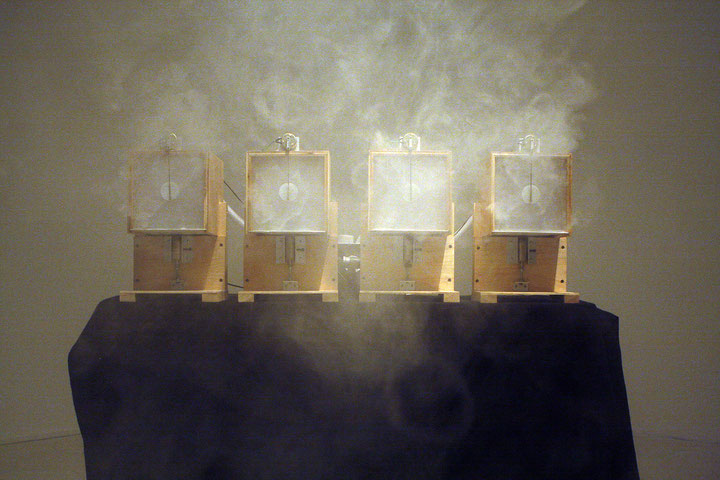Issue 1/2010 - Net section
The Angel of History in the Digital Age
»Feedforward – The Angel of History«, Gijón, Spain
Featuring 29 artworks by 27 artists and artist teams, Feedforward – The Angel of History is an ambitious project in scale and concept. Expertly curated by new media art heavyweights Christiane Paul and Steve Dietz, the exhibition and symposium grappled with the question of what progress might mean in the 21st Century, as the wreckage of political conflict and economic inequality continues to pile up.
History is a fragmentary tale at best, and though Paul and Dietz at no point intend to present an all-encompassing view, the overall feel of the show at times pleads a different case. This is echoed in the exhibition design by the »Office for Strategic Spaces«: instead of using traditional dividing walls, transparent partitions were placed in the main space, connecting the works visually, and allowing the spectator a dissected view of the show. While the designers claim this strategy allows the public to be in control, and connects the five organising thematic strands, its effect is rather the opposite, and needlessly clutters the exhibition experience with sensory and data overload. Here perhaps lies the flaw in an otherwise excellent exhibition: a restrained desire for completeness, to interlink stories and events reflecting the many faces of power, and its unequal distribution on political, economical, symbolical, and historical levels.
In this respect it is interesting that Hassan Elahi’s piece at the centre of the main space, »Instances of Use of United States Armed Forces Abroad, 1798-2006« (2009), unintentionally functions as a lens through which the show can be read. A transparent polycarbonate sheet featuring a map of the world shows used bullets, wherever the US has deployed its forces abroad. Yet there’s no real examination of the role of the US and its impact on the current geo-political climate. And perhaps the American perspective and US-centred gaze feature a little too strongly for an exhibition staged in Europe, as epitomized in activist pieces such as »Baghdad in No Particular Order« (2003) - Paul Chan’s video of life in the Iraqi capital prior to the American invasion, or Nonny de la Peña and Peggy Weil’s Second Life Guantánamo Prison simulation »Gone Gitmo« (2007-ongoing). In an exhibition project where the debris of reality hits back hard, »Gone Gitmo« and other Second Life projects, such as the main part of British duo Langlands and Bell’s »The House of Osama Bin Laden« (2003), Stephanie Rothenberg and Jeff Crouse’s »Invisible Threads – A Virtual Sweatshop« (2008), and T+T’s recreation of the Berlin Wall »Virtuelle Mauer/Reconstructing the Wall« (2009) all unfortunately fail to impress conceptually, or otherwise.
Nevertheless, an active critique of America’s expansionist policies becomes most arresting in projects that still manage to intervene in the semiotic landscape by symbolic transformation (to paraphrase Dutch media theorist Eric Kluitenberg during the conference). Piotr Szyhalski’s excellent sound piece »White Star Cluster« (2009) takes as its base a video-recorded dialogue between soldiers during a friendly fire attack in Ramadi (Iraq) and Eric Satie’s musical composition »Vexations«. The sonic re-enactment is simultaneously as beautifully estranged as it is piercing, and counters the televised rendering of war. Szyhalski manages to affect the listener in an emotional way, which images perhaps no longer have the power to do. This effective refusal to use generic representation receives a humorous treatment in Ali Momeni and Robin Mandel’s installation »Smoke and Hot Air« (2007-2008), in which the words »attack Iran« found in Google News are translated into speech and subsequently into smoke rings, produced by a quartet of smoke ring makers. Here the »smoke and hot air« of political fear-mongering is visualised aesthetically and methodically.
»The Angel of History« seems to question the meaning of value, or rather what is valuable nowadays. Cao Fei’s video »Whose Utopia«, filmed in Guangdong’s OSRAM China Lighting Ltd. factory, offers us a dreamlike narrative, wherein the Fordist assembly line is deconstructed in poetic and intimate sequences which alternate between machinery, workers and the manufactured light bulbs. Not only does this eventually attribute a subjective view of the workers, it equally anthropomorphises the non-human elements in the factory. Bárbara Fluxá’s commissioned »Proyecto Coche« (2006-2009) documents how archaeology and material culture intermingle, as she fishes an old and iconic Seat 127 car from a pond, and cleans it up. The car has lost its original value as a commodity, and has now been transformed into something different: a historical artefact, with its »objectness« reinstituted in the gallery space. The beautifully shot video of the excavation process, and display of the car carcass, show that although time cannot be reversed, it remains inscribed into all our future actions. This is the main lesson a project like »The Angel of History« teaches us.
Feedforward – The Angel of History, 22nd October 2009 until 5th April 2010
Symposium, 23rd & 24th October 2009
LABoral Centro de Arte y Creación Industrial, Gijón (Asturias) Spain
www.laboralcentrodearte.org
